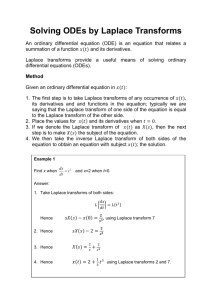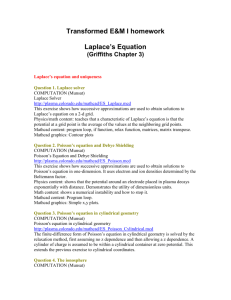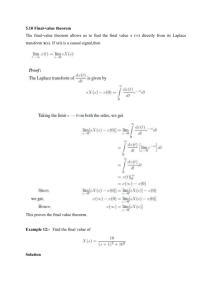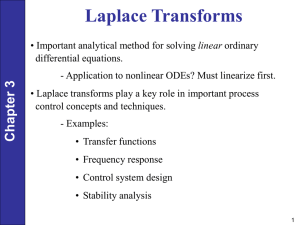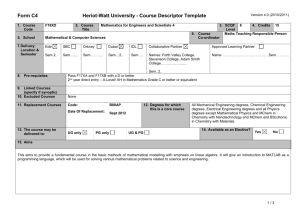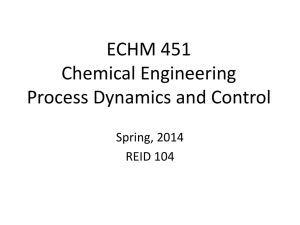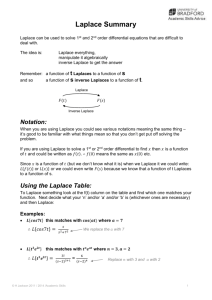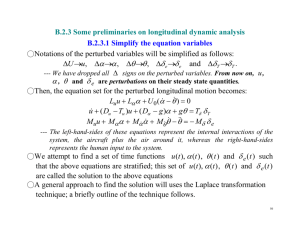Lecture Note: Chapter 6 (ppt file)
advertisement
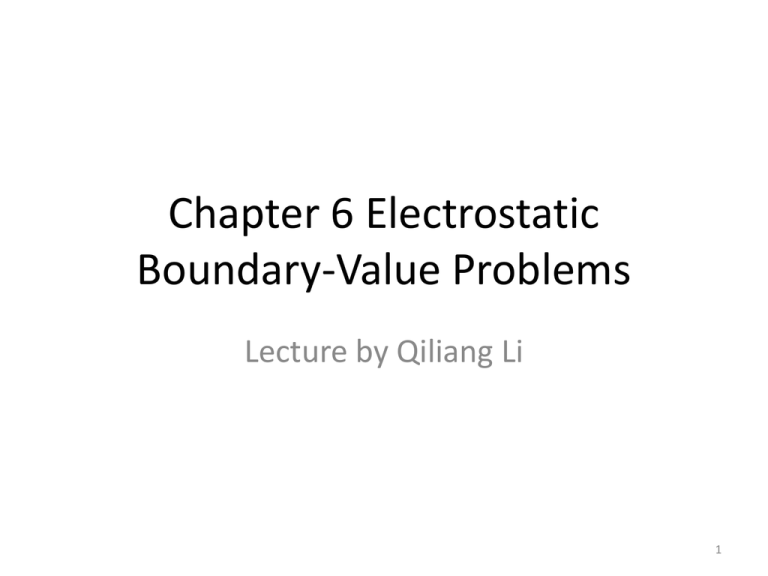
Chapter 6 Electrostatic Boundary-Value Problems Lecture by Qiliang Li 1 §6.1 Introduction The goal is to determine electric field E • We need to know the charge distribution – Use Coulomb’s law 𝑬= 𝑑𝑄 𝒂𝑹 4𝜋𝑅 2 or 𝑬 = – Use Gauss’s law 𝜓= 𝑆 𝑑𝑄 𝑹 4𝜋𝑅 3 𝑫 ∙ 𝑑𝑺 = 𝑄𝑒𝑛𝑐 • Or We need to know the potential V 𝑬 = −𝜵𝑉 2 §6.1 Introduction • However, we usually don’t know the charge distribution or potential profile inside the medium. • In most cases, we can observe or measure the electrostatic charge or potential at some boundaries We can determine the electric field E by using the electrostatic boundary conditions 3 §6.2 Poisson’s and Laplace’s Equations • Poisson’s and Laplace’s equations can be derived from Gauss’s law 𝛻 ∙ 𝐷 = 𝛻 ∙ 𝜖𝐸 = 𝜌𝑉 Or 𝜌𝑉 2 𝛻 𝑉=− 𝜖 This is Poisson’s Eq. If 𝜌𝑉 = 0, it becomes Laplace’s Eq. 𝛻2𝑉 = 0 4 Continue 6.2 The Laplace’s Eq. in different coordinates: 𝜕2𝑉 𝜕2𝑉 𝜕2𝑉 + 2+ 2 =0 2 𝜕𝑥 𝜕𝑦 𝜕𝑧 1 𝜕 𝜕𝑉 1 𝜕2𝑉 𝜕2𝑉 𝜌 + 2 + 2 =0 2 𝜌 𝜕𝜌 𝜕𝜌 𝜌 𝜕𝜙 𝜕𝑧 1 𝜕 𝜕𝑉 1 𝜕 𝜕𝑉 2 𝑟 + 2 𝑠𝑖𝑛𝜃 2 𝑟 𝜕𝑟 𝜕𝑟 𝑟 𝑠𝑖𝑛𝜃 𝜕𝜃 𝜕𝜃 1 𝜕2𝑉 + 2 2 =0 2 𝑟 𝑠𝑖𝑛 𝜃 𝜕𝜙 5 §6.3 Uniqueness Theorem Uniqueness Theorem: If a solution to Laplace’s equation can be found that satisfies the boundary conditions, then the solution is unique. 6 §6.4 General Procedures for Solving Poisson’s or Laplace’s Equations 1. Solve L’s Eq. or P’s Eq. using (a) direct integration when V is a function of one variable or (b) separation of variables if otherwise. solution with constants to be determined 2. Apply BCs to determine V 3. V E D 𝑱 = 𝜎𝑬 4. Find Q induced on conductor 𝑄 = 𝜌𝑆 𝑑𝑆, where 𝜌𝑆 = 𝐷𝑛 C=Q/V 𝐼 = 𝐽𝑑𝑆R 7 Example 6.1 (page 219) 8 9 10 Example 6.2 Details in P222 Example 6.3 13 14 15 §6.5 Resistance and Capacitance R’s definition (for all cross sections) 𝑬 ∙ 𝑑𝒍 𝑉 𝑅= = 𝐼 𝜎𝑬 ∙ 𝑑𝑺 Procedure to calculate R: 1. Choose a suitable coordinate system 2. Assume V0 as the potential difference b/w two ends 3. Solve 𝛻 2 𝑉 = 0 to obtain V, find E from 𝑬 = −𝛻𝑉, then find I from I = 𝜎𝑬 ∙ 𝑑𝑺 4. Finally, obtain 𝑅 = 𝑉0 /𝐼 16 (continue) Capacitance is the ratio of magnitude of the charge on one of the plates to the potential difference between them. 𝑄 𝜖 𝑬 ∙ 𝑑𝑺 𝐶= = 𝑉 𝑬 ∙ 𝑑𝒍 Two methods to find C: 1. Assuming Q and determining V in terms of Q (involving Gauss’s law) 2. Assuming V and determining Q interms of V (involving solving Laplace’s Eq.) 17 (continue) First methods QV, procedure: 1. Choose a suitable coordinate system 2. Let the two conductor plates carry Q and –Q 3. Determine E by using Gauss’s law and find V from 𝑉 = − 𝑬 ∙ 𝑑𝒍. (Negative sign can be ignored. We are interested at absolute value of V) 4. Finally, obtain C from Q/V 18 (continue) 19 (continue) 20 (continue) 21 (continue) 22 (continue) Example 6.8: a metal bar of conductivity σ is bent to form a flat 90o sector of inner radius a, outer radius b, and thickness t as shown in Figure 6.17. Show that (a) the resistance of the bar between the vertical curved surfaces at ρ=a 2𝑙𝑛𝑏/𝑎 and ρ=b is 𝑅 = 𝜎𝜋𝑡 (b) the resistance between the two horizontal surface at z=0 and z=t is 4𝑡 ′ 𝑅 = 𝜎𝜋(𝑏 2 − 𝑎2 ) x z b a y 23 (a) Use Laplace’s Eq. in cylindrical coordinate system: 1 𝑑 𝑑𝑉 2 𝛻 𝑉= 𝜌 =0 𝜌 𝑑𝜌 𝑑𝜌 𝑉 = 𝐴𝑙𝑛𝜌 + 𝐵 𝑉 𝜌 = 𝑎 = 0 → 0 = 𝐴𝑙𝑛𝑎 + 𝐵 𝑜𝑟 𝐵 = −𝐴𝑙𝑛𝑎 𝑉0 𝑉 𝜌 = 𝑏 = 𝑉0 = 𝐴𝑙𝑛𝑏 + 𝐵 𝑜𝑟 𝐴 = 𝑏 𝑙𝑛 𝑎 𝑉0 𝜌 So, 𝑉 = 𝐴𝑙𝑛𝜌 − 𝐴𝑙𝑛𝑎 = 𝑏 𝑙𝑛 , 𝑙𝑛 𝑬 = −𝛻𝑉 = − 𝐼= 𝑱 ∙ 𝑑𝑺 = 𝑉0 𝑏 𝜌𝑙𝑛 𝑎 𝑎 𝑎 𝒂𝝆 , 𝐽 = 𝜎𝑬, 𝑑𝑺 = −𝜌𝑑𝜙𝑑𝑧𝒂𝝆 , 𝜋 𝑡𝑉0 𝜎 , 2 𝑙𝑛 𝑏 𝑎 𝑅= 𝑉0 𝐼 = 2𝑙𝑛 𝑏 𝑎 𝜎𝜋𝑡 24 (b) Use Laplace’s Eq. in cylindrical coordinate system: 2 𝑑 𝑉 2 𝛻 𝑉= 2 =0 𝑑𝑧 𝑉 = 𝐴𝑧 + 𝐵 𝑉 𝑧 = 0 = 0 → 0 = 0 + 𝐵 𝑜𝑟 𝐵 = 0 𝑉0 𝑉 𝜌 = 𝑡 = 𝑉0 = 𝐴𝑡 + 𝐵 𝑜𝑟 𝐴 = 𝑡 𝑉0 So, 𝑉 = 𝑧, 𝑡 𝑬= 𝐼= 𝑉0 −𝛻𝑉 = − 𝒂𝒛 , 𝐽 = 𝜎𝑬, 𝑑𝑺 = −𝜌𝑑𝜙𝑑𝜌𝒂𝒛 , 𝑡 𝑉0 𝜎𝜋(𝑏2 −𝑎2 ) 𝑱 ∙ 𝑑𝑺 = , R=V0/I=? 4𝑡 (please also use conventional method for (b)) 25 Example 6.9: a coaxial cable contains an insulating material of conductivity σ. If the radius of the central wire is a and that of the sheath is b, show that the conductance of the cable per unit length is 𝑏 𝐺 = 2𝜋𝜎/𝑙𝑛 𝑎 Solve: Let V(ρ=a)=0 and V(ρ=a)=V0 𝐽 = 𝜎𝑬 = 𝐼= 2𝜋𝐿𝜎𝑉0 𝑙𝑛𝑏/𝑎 −𝜎𝑉0 , 𝜌𝑙𝑛𝑏/𝑎 𝑑𝑺 = −𝜌𝑑𝜙𝑑𝑧𝒂𝝆 R per unit length =V/I/L G=1/R= … a b 26 Example 6.10: find the charge in shells and the capacitance. Solve: Use Laplace’s Eq. (spherical) And BCs, 𝑉 = 𝑉0 1 1 ( − ) 𝑟 𝑏 1 1 ( − ) 𝑎 𝑏 V0=100V b a GND Єr So E=-dV/dr ar, Q=?, C=Q/V0 27 Example 6.11: assuming V and finding Q to derive 𝑄 𝜖𝑆 Eq. (6.22): 𝐶 = = 𝑉 𝑑 Solve: From Laplace’s Eq.:𝛻 2 𝑉 = 0 𝑑2 𝑉 2 𝑑𝑥 = 0𝑉 = 𝐴𝑥 + 𝐵 x d V0 0 0 From BCs: V(0)=0 and V(x=d)=V0 𝑉0 𝑉= 𝑥 𝑑 𝑉0 So, 𝐸 = −𝛻𝑉 = − 𝒂𝒙 , the surface charge: 𝜌𝑠 = 𝐷 ∙ 𝒂𝒏 = 𝜖𝑉0 − 𝑄 𝑑 𝑑 = 𝜌𝑠 𝑆 𝜖𝑉0 = S, 𝑑 so: 𝐶 = 𝜖𝑆 𝑑 28 Example 6.12: determine the capacitance of each of th Єr1=4 e capacitors in Figure 6.20. Take Єr2=6, d=5mm, S=30 cm2. Solve: d/2 Є (do it by yourself) Є d/2 r1 r2 Єr1 Єr2 w/2 w/2 29 Example 6.13: A cylindrical capacitor has radii a=1cm and b=2.5cm. If the space between the plates is filled with and inhomogeneous dielectric with Єr=(10+ρ)/ρ, where ρ is in centimeters, find the capacitance per meter of the capacitor. Solve: Use Eq. 6.27a, set the inner shell with +Q and 𝑎 𝑄 outer shell with –Q. 𝑉 = − 𝑏 𝑑𝜌 = 𝑄 10+𝑏 𝑙𝑛 2𝜋𝜖0 10+𝑎 2𝜋𝜖0 𝜖𝑟 𝜌𝐿 C=Q/V=…=434.6 pF/m 30 §6.6 Method of Images • The method of images is introduced by Lord Kelvin to determine V, E and D, avoiding Poison’s Eq. • Image Theory states that a given charge configuration above an infinite grounded perfect conducting plane may be replaced by the charge configuration itself, its image, and an equipotential surface in place of the conducting plane. 31 Conducting plane grounded Image charge So that the potential at the plane position = 0V 32 Equipotential V=0 Perfect conducting surface grounded In applying the image method, two conditions must always be satisfied: 1. The image charge(s) must be located in the conducting region (satify Poisson’s Eq.) 2. The image charge(s) must be located such that on the conducting surface(s) the potential is zero or constant 33 A. A point charge above a grounded conducting plance 34
